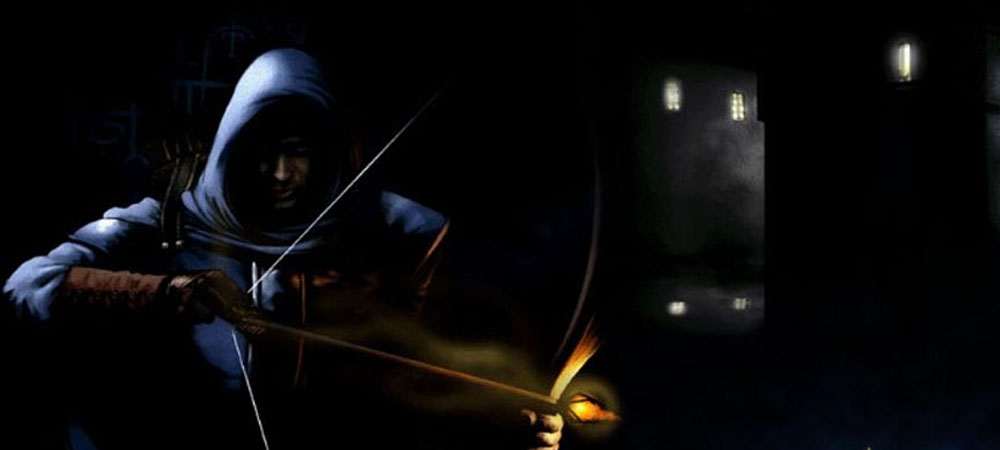Gimme the loot
I love Thief. If you follow me on Twitter, you may have seen me singing the series’ praises as I played through Thief 1 & 2 late last year. Finally plunging into the defunct Looking Glass Studios’ crowning achievement gave me much to talk about. Its art direction, level design, and mechanics ooze atmosphere, despite the low number of polygons that date the game’s engine.
While Fraser Brown looked toward the future of the franchise, I’d like to take this opportunity to discuss Thief‘s past. With the reveal of Thief 4, I am unsure of what to expect but I do know what I love about the original games. These are also the things that I’d like to see Eidos Montreal embrace.
 Handmade maps
Handmade maps
Immersion can come from many things, but it doesn’t often come from maps. Maps in games, especially in the Doom era, are pristine things composed of perfect lines that magically appear as the player explores. In Doom, everything except hidden items are displayed for the player. It serves as a tool in navigating the environment but one that often took the player out of it.
Thief, on the other hand, gave the player mingy, torn, and often illegible maps with incomplete info. You can imagine someone concealing these between their cheeks, handing the poo-ridden map to master thief Garret in a back alley. Thief is a game about being resourceful with what you have, and nowhere is this truer than the maps that left enemies, starting position, direction, and items to uncertainty.
There may be handwritten notes that will guide you, but maybe you can’t read them. There may be a detailed section on one page, but you’re not sure if you are near it. Thief 2 made this a bit easier, since it highlighted your position (but not direction). It’d be great if Thief 4 kept this unorthodox element but let players draw on their maps and add notes.
 Abstract level design
Abstract level design
Games have become more realistic, to the point that Thief‘s architecturally-challenged levels resemble Quake more than Half-Life. As exciting as it was to explore the city streets and taverns of Thief, it was the labyrinthine estates and caves that left the biggest impression on me. I worry this element may be lost in Thief 4, as abstract level design is no longer favored by critics and consumers who desire realism.
I’ll never forget The Sword (mission) in Thief Gold; it’s one of the most haunting, surreal levels I’ve ever come across in a videogame. It reminded me of the novel House of Leaves, in which homeowners find an abyss below their house that goes on and on. Sexual moans echo throughout the level and surprise traps lay behind certain doors, making the mansion an uncomfortable, threatening place to be.
If it were mapped out like a level from Dishonored or Deus Ex: Human Revolution, it wouldn’t be the same. It wouldn’t capture that romantic feeling of adventuring into the unknown with great uncertainty. It gave players a glimpse of what a game designed by Stanley Kubrick would be like.
 Ambiance
Ambiance
Silence is hard to find, these days, even in games. Orchestras swell, indicating an incoming enemy, and rooms bustle with noise that make the environment feel more animated. But, in Thief, you’d only hear the patter of your footsteps, encouraging the player to crank the volume up in order to catch the echo of a distant guard — only to jump out of the seat when one appears right behind Garrett.
Thief is a series with a great amount of style, between its steam punk setting to its gorgeously lit (for the time) locations. Developer Looking Glass exerted a great amount of restraint in the design of the game, creating a world that feels dangerous and all too real at times. While console titles offered more bombastic, cinematic adventures, Thief offered something much more personal and frightening.
 Sandbox approach and environment
Sandbox approach and environment
A thief is nothing without tools and Garrett has plenty of them. More so than even Deus Ex and System Shock, Thief is a series that gives the player a wealth of options in approach. The environment offers many alternative paths and Garrett’s tools offer many different approaches to dealing with guards. A crafty player can use moss arrows to silently walk across metallic surfaces, while a more patient player may douse hallway torches with water arrows.
There is no better feeling then skipping an entire floor of troubles with a well-placed rope arrow that Garrett can shimmy up. I worry that Thief 4 may offer more aggressive approaches that will ruin the tone and pace of the original games which offered many approaches but all of which require stealth and careful planning. Approaching with a sword only gets you so far in Thief. Let’s hope it remains this way.
 High tension
High tension
Thief often feels like a survival horror game to me. You have the dimly lit, foreboding locales, item management, and most of all, nail-biting tension that comes from hiding inches away from enemies that can kill Garrett in two or three blows. By its very nature, Thief is a game best played with your fingers constantly hovering over the quick-save/quick-load buttons, as the repercussions for being caught can be drastic. Something that Eidos seeks to change, to my chagrin.
Due to a sense of tension that can become very unnerving over time, there is nothing all that pleasant about playing Thief. The player doesn’t unlock abilities or increase stats; there is never an advantage beyond becoming more cunning and aware. The onus is on the player to adapt and improve, slowing down the pace of their steps and always looking for hidden passages. It’s something that games just don’t do anymore, and I don’t think Thief 4 will buck this trend.


